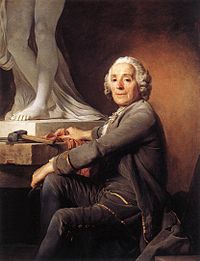Christophe-Gabriel Allegrain

Christophe-Gabriel Allegrain (11 October 1710, Paris – 17 April 1795, Paris) was a French sculptor who tempered a neoclassical style with Rococo charm and softness, under the influence of his much more famous brother-in-law, Jean-Baptiste Pigalle.
Biography
Allegrain was born into a well-established family of landscape painters in
After the King's death she was pleased enough with it to commission from Allegrain a pendant bather in 1776, which he delivered in 1778 (illustration). presented in the landscape garden as Vénus and Diane they provided an allegory of her past sensual love and her present chaste condition. (Both are conserved in the Louvre Museum.) There are small-scale patinated bronze reproductions, and both pieces remained popular and often reproduced through the nineteenth century: in 1860, when the Goncourt brothers referred to "the refined legs of a Diana of Allegrain",[1] their readers conjured up the familiar image.
His portrait by
Notes
- ^ "les jambes fines d'une Diane d'Allegrain", Les hommes de lettres 1860 (on-line Archived 2005-10-12 at the Wayback Machine)
References
- Geneviève Bresc-Bautier, Isabelle Leroy-Jay Lemaistre (sous la direction de Jean-René Gaborit, Musée du Louvre. département des sculptures du Moyen Âge, de la Renaissance et des temps modernes. Sculpture française II. Renaissance et temps modernes vol. 1 Paris, 1998
External links
![]() Media related to Christophe-Gabriel Allegrain at Wikimedia Commons
Media related to Christophe-Gabriel Allegrain at Wikimedia Commons
- Christophe-Gabriel Allegrain in American public collections, on the French Sculpture Census website
